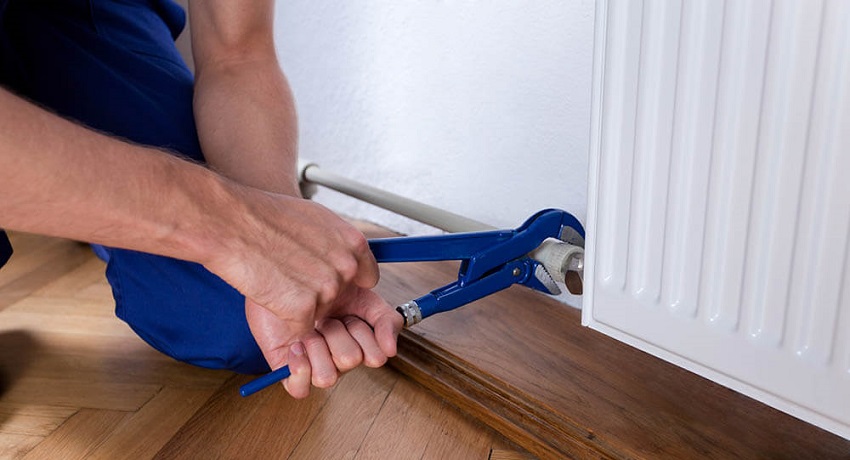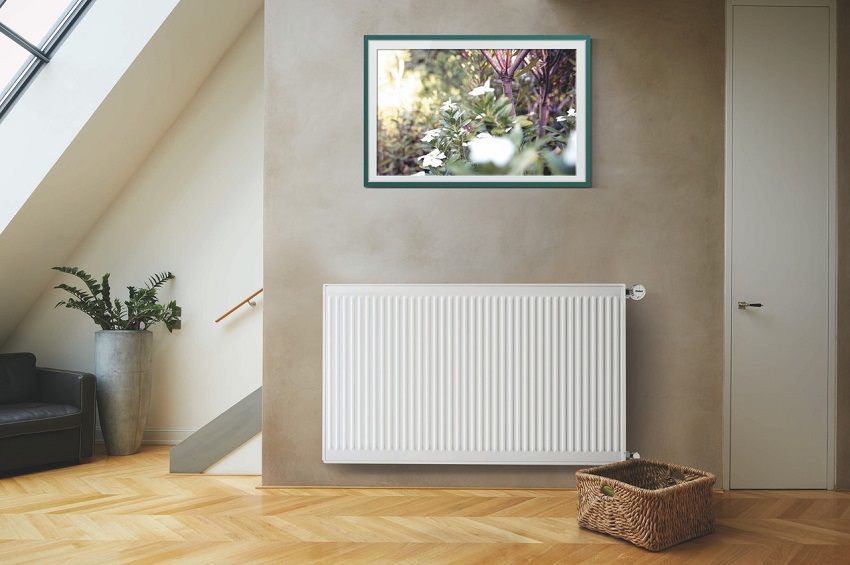Over time, urban apartment buildings have to be repaired with the replacement of the old heating circuit. Lateral connection of panel radiators is a classic scheme when both pipes are connected to the heating block from the side. But the flat panels themselves, gradually replacing their ribbed predecessors, have their own specifics, which it is important to know about before installing them.
Content
Features of panel bimetallic and steel radiators
Old cast-iron batteries are gradually fading into oblivion, although today designer models for retro lovers in interiors are still being produced.
In modern apartments, relatively new offers are popular:
- steel panel radiators "Kermi";
- Purmo bimetal batteries;
- aluminum and copper (rarer due to high cost).
The search for new varieties of heating equipment is primarily associated with the need to replace clogged pipes and batteries that have become “cold”. This relatively quick wear is caused by the low quality of the water filling the system in the form of a coolant. Organic sludge, excess calcium and rust gradually constrict the duct, reducing the efficiency of heat supply.
With central heating, system tests are often performed, so bimetallic and steel models are preferable to aluminum. They are sensitive to the acidity of water and abrasive particles carried under high pressure during water hammer.
Attention! Radiators without a Majewski tap are often aired, regardless of the metal and type of connection. These cranes are recommended for installation on the upper floors, but can be provided in any room.
Panel-type bimetallic radiators can cope with these problems much better, thanks to their design features. Visually, they have a lot in common with sectional radiators with narrow gaps. Here, the outer panels hide the pipes through which the coolant passes.
The shape of batteries with a thin metal shield absorbs a little heat for its own heating, the rest goes to the heating of the air masses.
What is important to consider before buying a panel radiator
As a rule, in the living rooms of city apartments, one window sill is reserved for batteries. However, their number and format may vary if the microclimate leaves much to be desired.
Advice! When the old ribbed blocks do not suit for efficiency, and the temperature in the room is below 20 ° C, it is better to purchase a panel radiator with a larger surface area.
Before buying thermal equipment, it is important to determine the type of radiator, how to connect it and the need for additional equipment:
- pipes;
- a set of adapters and fittings, especially if it is necessary to adjust the width of the holes and the diameters of the pipes.
With a side connection of panel radiators, it is supposed to dock with an incoming pipe from above from the side and leading out from below.Tight and reliable installation is made by means of a threaded connection. An effective closed circuit is formed only when the connection is correct, where the coolant flows by gravity from the upper collector to the lower outlet to the outlet - through the entire radiator design.
The quality of joining the panel radiators to the pipes largely depends on the indicators of metal - rolled steel for their production and its thickness. These models are not designed for high system pressure. The inner surface is subject to corrosion, even if “stainless steel” is indicated in the technical description. Over time, in such radiators the wall becomes thinner (initially 1.25 - 2.5 mm) and becomes covered with plaque, making them brittle. Working pressure up to 10 Bar becomes extreme, therefore such models are relatively cheap, although they will last more than 10-15 years.
Ways to connect radiators
Steel panel radiators have gained popularity due to their aesthetics and convenience in terms of cleaning. Washing flat panels is much more convenient than ribbed batteries. Models are available with a different number of inlets, but they are also used for lateral connection of panel radiators. Today, 3 varieties (with their subspecies) of connection are practiced.
Panel radiators are connected in different ways:
- Lower.
- Side.
- Diagonal.
In country houses, they often use a radiator connection from below, in apartments with centralized heating, bimetallic models are connected in the classical way - from the side. At the same time, the water supply goes from above, passes through all pipes (sections, blocks, departments) with a tap into the general communications from below.
New models attach differently to the wall and pipes. Multisection radiators can be increased, panel radiators can not, its thermal return (power) is calculated in advance.
An important point! A radiator with a decorative shield absorbs 10-15% of heat, reducing efficiency. In the case of panel radiators, on the contrary, the external structural part is designed to heat the air. In models with double panels (front and rear), the efficiency increases. They can be installed on either side.
How and where to install a panel radiator
In city apartments, under each window there is a special niche for placing a heating block. This is the best place for its installation. Cold air from the window slides onto the warm panel of the heater, warming up, rises. This is how circulation and heating of air masses and blocking of cold flows occur. Batteries hide window shades and curtains, so this is advisable even for aesthetic reasons.
Useful tips for installing panel radiators for the private sector:
- if there are more than 2 windows in the room, place radiators opposite each other in order to “parallelize” warm air currents for even heat distribution;
- do not install a heating circuit with rare batteries, this is an unreasonable saving even in an insulated building - there will be cold and warm zones, it is better to put small blocks at regular intervals;
- the gravity flow scheme is rational, but not the best, a boiler with a pump is recommended, which will effectively drive the coolant to the most remote radiator;
- it is undesirable to bend the pipes of the heating system strongly, since it is precisely in the corners that they are most often forgotten by sediment and rust;
- in an elongated room, the collectors (entrances) should not be on the end walls, in extreme cases, it will be necessary to duplicate with small panel radiators on the long wall, especially if it is external and poorly insulated;
- pipes under the floor, ceiling and finishing materials are best done with a minimum of connections to minimize leaks.
In city apartments, sometimes you have to put batteries at the front door, especially if it's the first floor. Often heating appliances lead to an insulated balcony or loggia. In this way, it is easiest to minimize heat loss, but housing workers most often resist the proposal to weld another battery to the circuit.
Without notifying the management company, it is forbidden to independently change the scheme, the method of connecting radiators, mount shut-off valves in the absence of bypasses and make other “home-made products”.
When doing self-installation, remember that when connecting panel radiators laterally, the input coolant flow must be supplied from above and discharged into the lower hole.
Attention! The distance from the battery to the floor, window sill and ceiling should be sufficient for uniform passage of air masses - 10-15 cm, against the wall - 5-8 cm.
Do-it-yourself installation of a panel radiator usually does not cause problems. This does not take much time if there is experience in connecting polymer pipes with fittings and other components. However, it is important to comply with all technology requirements in order to avoid problems with leaks in the future. It should also be remembered that the outer panel is quite flexible. It is easy to damage it mechanically, and fixing the defect is quite difficult.
Independent connection of panel radiators in a side way
This type of battery has a lower weight than other varieties, so it does not need reinforcement when hanging on brackets. They are adapted for 1-pipe and 2-pipe schemes, for their functioning a fairly small amount of coolant.
Lateral connection assumes the presence of an extension of flow removal - a part with a tube screwed into the inlet. Due to it, the intake (release) of the coolant is activated at the far point of the radiator, the flow will flow uniformly along the diagonal.
In a house with a vertical supply of warm water, a lateral one-way connection is the main scheme of buildings with a centralized system that ensures a good return of panel blocks.
Before starting the installation, they shut off the heating system and dismantle the old battery. Under a new one, they designate a place for the bracket on the wall. For a soft wall, you need dowels.
The installation process does not take much time, if you wish for technology. As a rule, foreign companies (Buderus, Purmo) offer fasteners complete with a radiator. The description should contain instructions translated into Russian (imported goods). The fittings with union nuts are screwed into the radiator during installation, and the tap is screwed onto the pipe, wrapped with a nut. For high-quality assembly, you need a key suitable for "American" women. From improvised means use an open-end wrench stuck in the fitting (if amenable to twisting).
When assembling the radiator, it is imperative to "fill" all 4 holes - adapters into pipes, a Mayevsky tap or plug. All connections are carefully sealed, you can use Unipak paste. Pay attention to the right and left threads while applying tow type seals.
The installation of ball valves as shut-off valves allows further unhindered cleaning or blocking of a separate radiator. The implementation of the recommendations will exclude leaks and the failure of the heating system.











